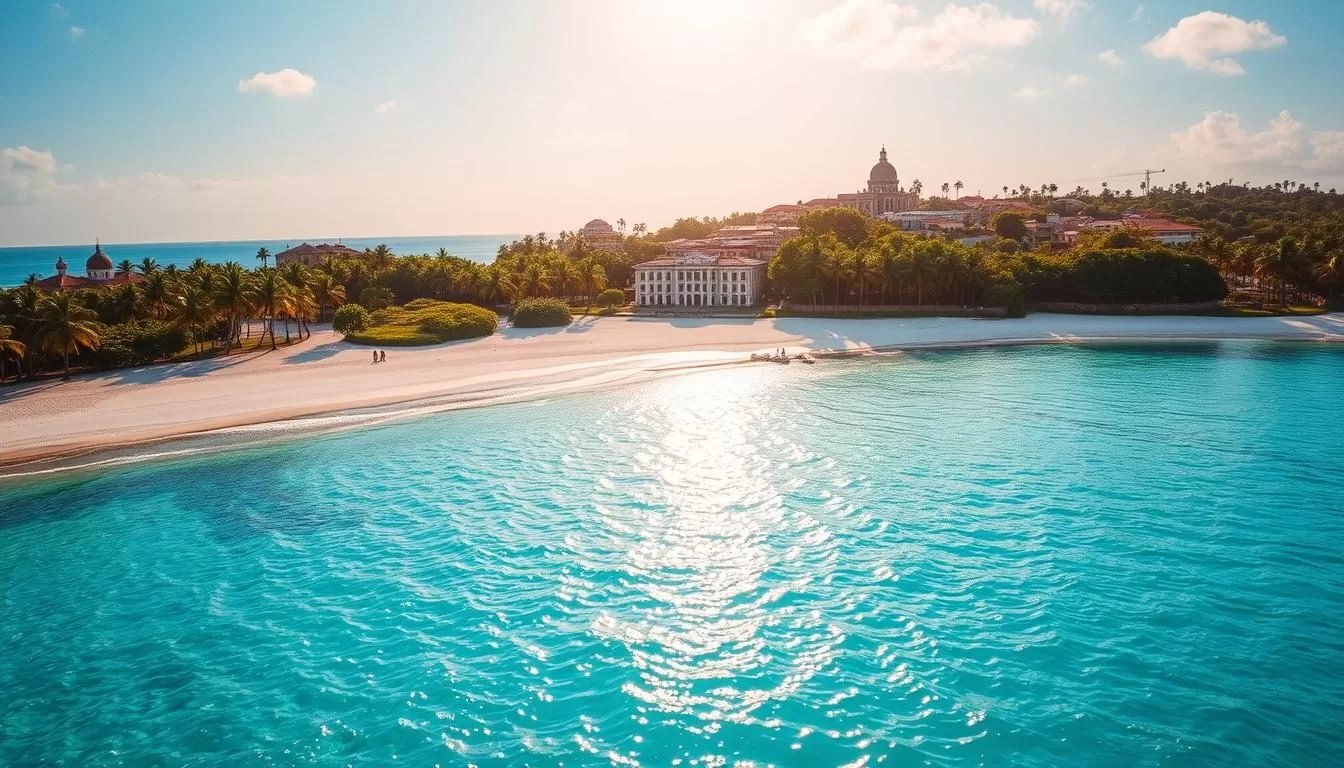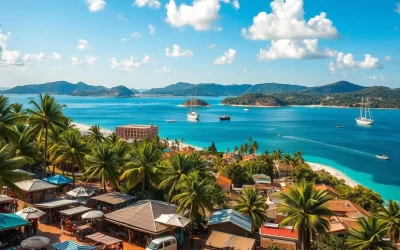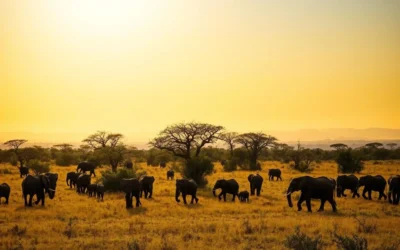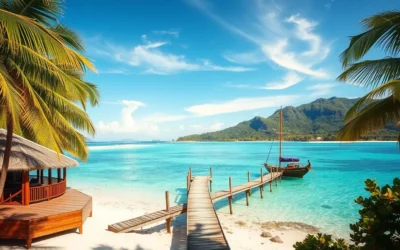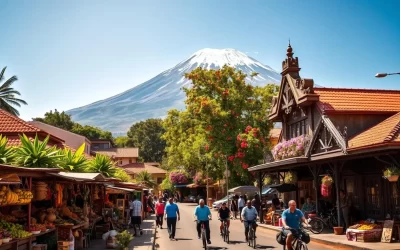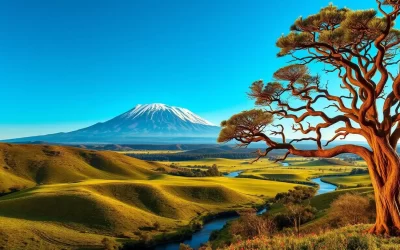Imagine a tropical getaway with crystal-clear waters and exciting wildlife experiences. The Zanzibar Archipelago is a hidden gem off the coast of Tanzania, offering an intoxicating blend of pristine beaches, rich cultural heritage, and unforgettable experiences.
Welcome to this enchanting destination, often called the “Spice Island” for its historical significance as the world’s largest producer of cloves. The unique cultural tapestry, influenced by Arabic, Indian, and Swahili traditions, adds to its allure.
As you plan your trip, you’ll discover the absolute best things to do in this tropical paradise, from exploring the historic Stone Town to swimming with marine life in crystal-clear waters.
Discovering the Magical Zanzibar Archipelago
As you step into the enchanting world of Zanzibar, you’ll uncover a treasure trove of history, culture, and natural beauty. The archipelago, comprising several islands, is a haven for travelers seeking a unique and unforgettable experience.
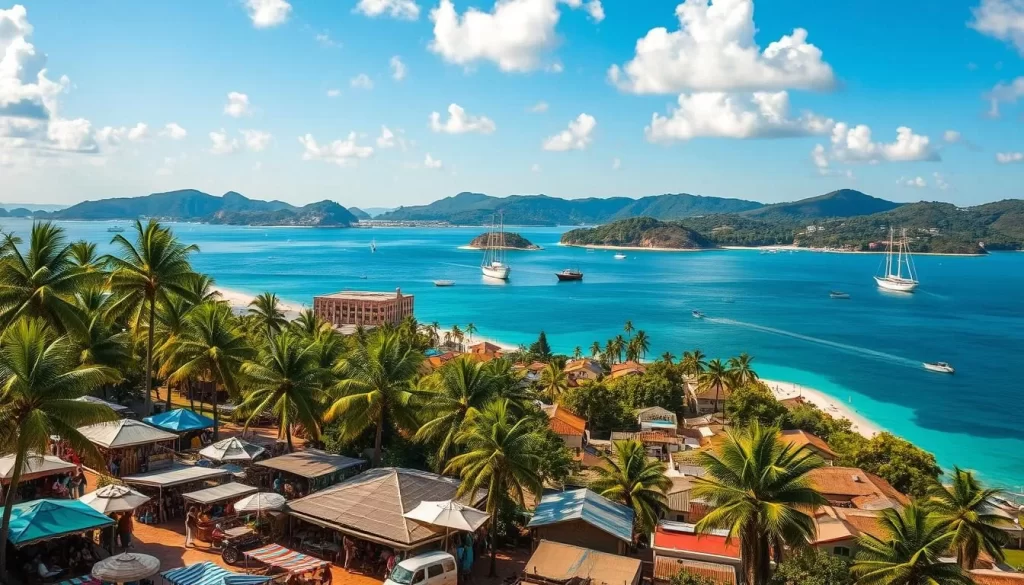
The Spice Island’s Rich History and Cultural Blend
Zanzibar is renowned as the “Spice Island” due to its historical significance in the production of spices such as cloves, cinnamon, and nutmeg. This legacy is a result of its strategic position as a trading hub connecting Africa, the Middle East, and Asia. The cultural blend here is a fascinating blend of African, Arab, Persian, Indian, and European influences, visible in the architecture, cuisine, and local traditions.
The unique cultural heritage of Zanzibar is a result of centuries of interaction between different cultures. You’ll be captivated by the mesmerizing fusion that has evolved here, from the intricately carved doors to the vibrant markets and the delectable Swahili cuisine.
- The history of Zanzibar as a major trading center has left an indelible mark on its culture and architecture.
- The blend of cultures is reflected in the daily life, festivals, and traditions of the local people.
Geography and Climate: When to Visit Zanzibar
Understanding Zanzibar’s geography and climate is crucial for planning your visit. The archipelago consists of several islands, with Unguja (commonly known as Zanzibar Island) and Pemba being the largest. Each island offers distinct landscapes and experiences, ranging from pristine beaches to lush forests.
The best time to visit Zanzibar is during the dry season, which occurs in two periods: June to October and January to February. During these times, you can enjoy sunny days with temperatures averaging 28-30°C (82-86°F), ideal for beach activities and exploring the islands without the hindrance of heavy rainfall.
Visiting during the Zanzibar dry season ensures that you can fully appreciate the beauty and charm of the archipelago. The dry conditions make it easier to navigate the islands and participate in outdoor activities such as snorkeling, diving, and spice tours.
Exploring Stone Town: A UNESCO World Heritage Site
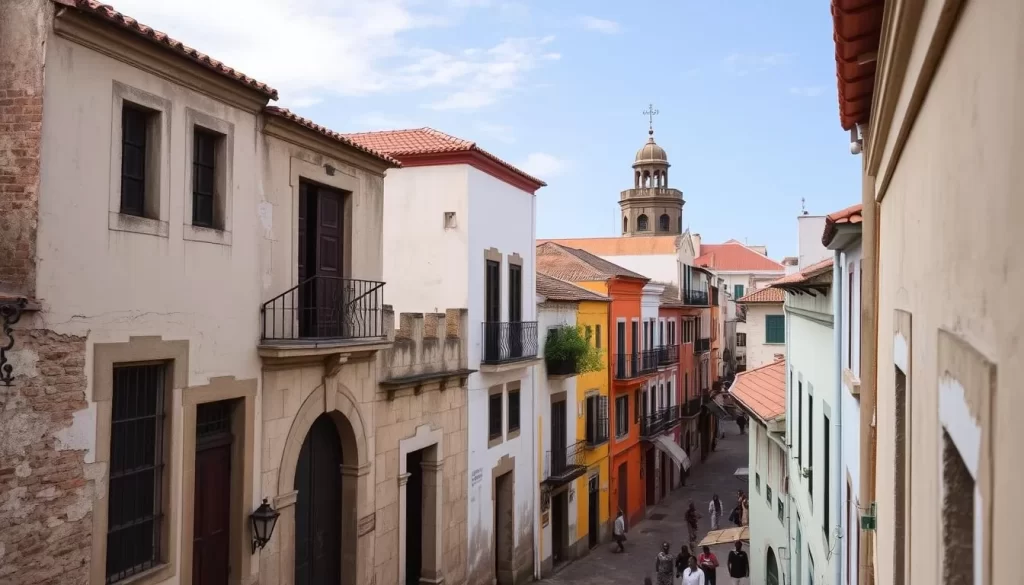
With its narrow streets and ancient buildings, Stone Town is a living museum that showcases Zanzibar’s diverse heritage. As the historic center of Zanzibar City, it has been recognized as a UNESCO World Heritage Site for its remarkable preservation of Swahili coastal trading town culture.
Historic Landmarks and Architectural Wonders
Stone Town is replete with historic landmarks that reflect its rich cultural tapestry. The House of Wonders, one of the most iconic buildings, stands as a testament to Zanzibar’s architectural heritage. Other notable sites include the Old Fort of Zanzibar and the People’s Palace Museum, each offering a unique glimpse into the island’s history.
The intricate wooden doors and the imposing structures like the Sultan’s Palace are a treat to behold, showcasing the blend of African, Arab, and European influences.
Navigating the Narrow Streets and Bustling Markets
As you navigate the labyrinthine narrow streets of Stone Town, you’ll be immersed in a lively atmosphere. The bustling markets, such as Darajani Bazaar, offer a sensory experience with their array of fresh produce, spices, and handcrafted goods. It’s an ideal place to observe local life and perhaps pick up some unique souvenirs.
The Darajani Fish Market and Forodhani Gardens Night Market are other must-visit spots, offering a taste of the local cuisine and street food.
Stone Town’s Cultural Significance and Colonial Past
Stone Town’s cultural significance is deeply intertwined with its colonial past. The Old Slave Market, now converted into an Anglican Cathedral, serves as a poignant reminder of the island’s dark history in the slave trade. The original holding cells beneath the church are a sobering experience, highlighting the importance of understanding and respecting the local history.
The blend of cultures in Stone Town is a result of centuries of interaction between African, Arab, Indian, and European influences, making it a unique cultural fusion point.
Prison Island: Giant Tortoises and Historical Sites
Located just off the coast of Stone Town, Prison Island is a fascinating destination that offers a unique blend of history and natural beauty.

Prison Island, also known as Changuu Island, is a small island located just a short boat ride from Stone Town. The island has a rich history, having been used as a prison for rebellious slaves in the 1860s and later as a coral mine.
Meeting the Ancient Aldabra Tortoises
One of the main attractions of Prison Island is its population of giant Aldabra tortoises. These incredible creatures, some of which are over 150 years old, were originally a gift from the British governor of the Seychelles in 1919.
The tortoise sanctuary on Prison Island is a result of conservation efforts, and the numbers have risen significantly since the initial four tortoises were introduced.
As you walk around the island, you’ll have the opportunity to meet these gentle giants up close and learn about the conservation efforts in place to protect them.
The Former Slave Prison and Its History
The island’s name is derived from its original intended purpose as a prison for rebellious slaves in the 1860s. Although the prison complex built in 1893 was never used for incarceration, it did serve as a quarantine station for people with yellow fever for a short period.
The historical significance of Prison Island is palpable as you explore the remnants of the prison complex and learn about its past.
Today, visitors can enjoy the island’s crystal clear waters, perfect for swimming and snorkeling among vibrant marine life. The island’s white sand beaches offer a serene atmosphere, making it an ideal day trip from Stone Town.
A visit to Prison Island offers a perfect balance of wildlife encounter, historical exploration, and beach relaxation. With its rich history and natural beauty, Prison Island is a must-visit destination for anyone traveling to Zanzibar.
Zanzibar Archipelago, Tanzania: Best Things to Do for Beach Lovers
As you explore the Zanzibar Archipelago, you’ll discover a treasure trove of breathtaking beaches that cater to all tastes. The archipelago is renowned for its white sand beaches and crystal-clear waters, making it a paradise for beach lovers. Whether you’re looking for vibrant nightlife, water sports, or secluded escapes, Zanzibar has something for everyone.
Nungwi and Kendwa: Northern Paradise Beaches
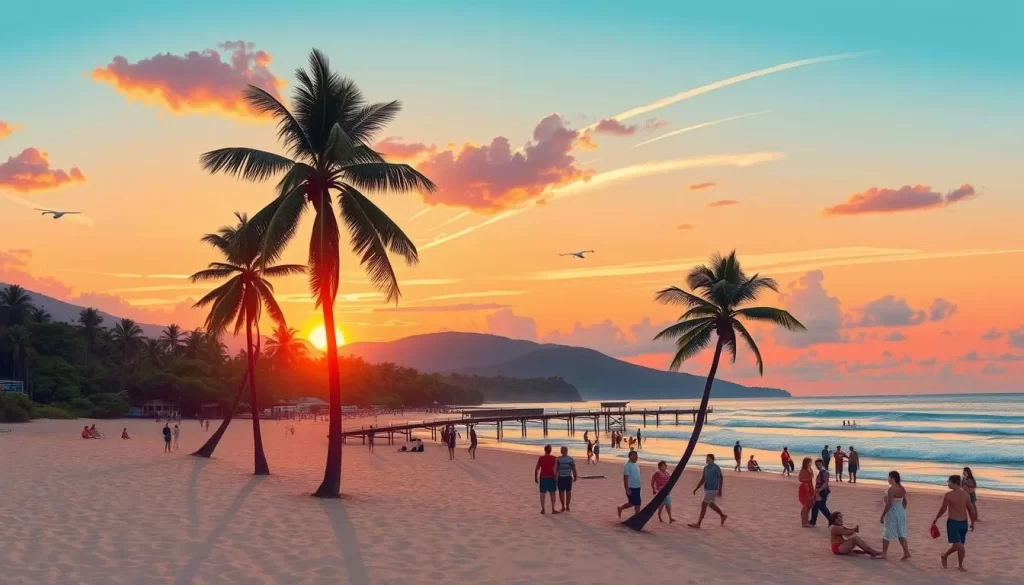
Nungwi and Kendwa beaches are two of the most popular destinations in northern Zanzibar. Nungwi Beach is known for its lively atmosphere, water sports, and stunning sunsets. You can enjoy snorkeling, diving, or simply relaxing on the beach. Nearby, Kendwa Beach offers a more relaxed vibe with calm waters, making it ideal for solo travelers and those seeking serene sunsets.
Paje and Jambiani: Eastern Coast Gems
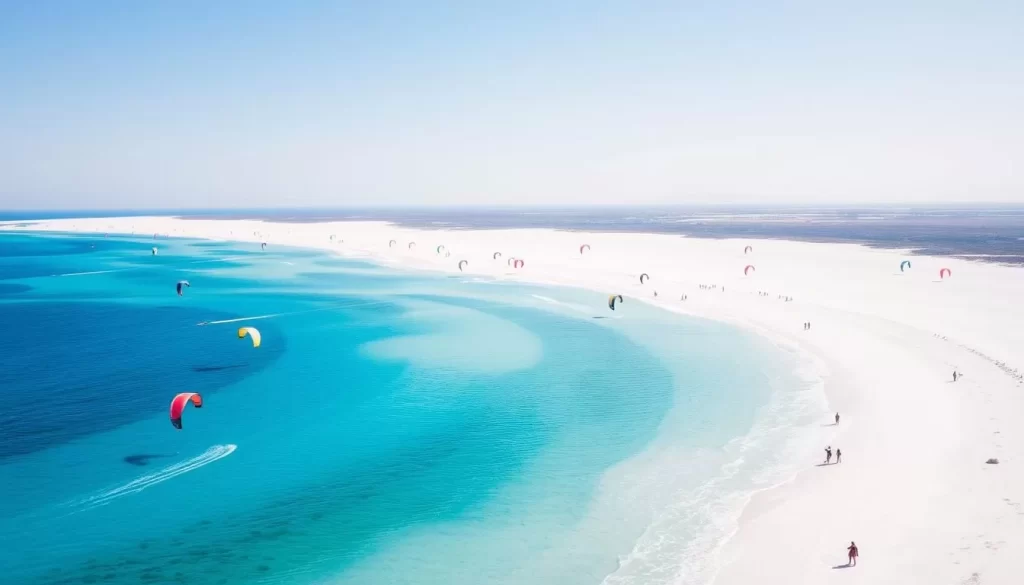
The eastern coast of Zanzibar is home to the beautiful beaches of Paje and Jambiani. Paje Beach is famous for its kite-surfing conditions and vibrant nightlife. You can witness local women engaged in seaweed farming during low tide and enjoy the perfect conditions for water sports when the wind picks up. Similarly, Jambiani Beach offers a stunning beach and lively village scene, making it another gem on the eastern coast.
Michamvi and Bwejuu: Secluded Beach Escapes
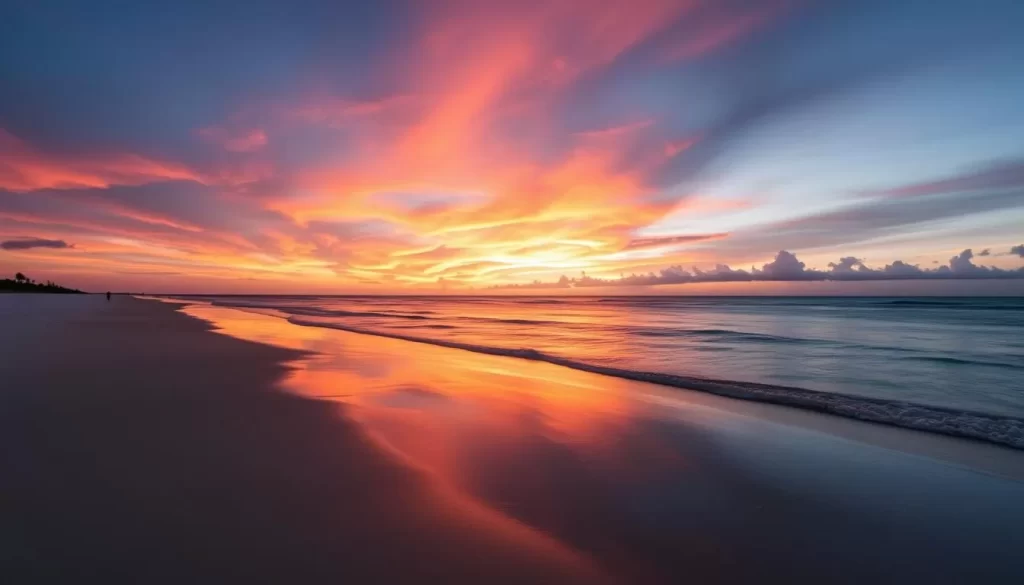
For those seeking more secluded experiences, the beaches of Michamvi and Bwejuu provide tranquil escapes with fewer crowds. Michamvi Beach is known for its stunning sunset views and quieter ambiance, while Bwejuu Beach offers a serene atmosphere and picturesque views of the Indian Ocean. Both beaches are perfect for relaxation and unwinding in a peaceful setting.
Zanzibar’s beaches are among the best things to experience on the archipelago, with each coastal area offering its unique charm and atmosphere. The dramatic tidal changes make these beaches truly special, with low tide allowing you to walk on exposed sandbars and high tide bringing perfect swimming conditions.
Underwater Adventures: Snorkeling and Diving Hotspots
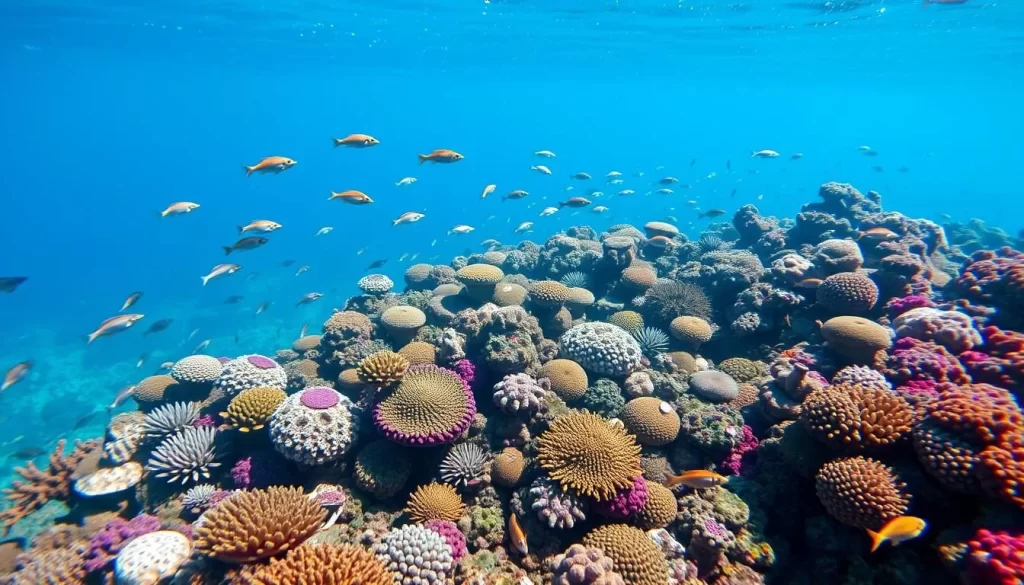
Beneath the turquoise waters of Zanzibar lies a vibrant underwater world, full of coral reefs and diverse marine life. This archipelago off the coast of Tanzania is renowned for its incredible snorkeling and diving opportunities, making it a must-visit destination for enthusiasts of the ocean.
Mnemba Atoll: World-Class Coral Reefs
Mnemba Atoll stands out as a crown jewel among Zanzibar’s coral reefs. This protected marine conservation area is home to an astonishing array of marine biodiversity, with over 600 species of fish. Snorkelers and scuba divers alike can explore the atoll’s pristine reefs, experiencing the vibrant colors and intricate structures of the coral.
The atoll’s conservation efforts have ensured that the coral reefs remain healthy and thriving, providing a rich environment for marine life. Visitors can expect to see a kaleidoscope of fish, alongside other creatures such as sea turtles and dolphins.
Tumbatu Island and Leven Bank: Diving for All Levels
For those looking to explore the underwater world through scuba diving, Tumbatu Island offers excellent dive sites suitable for beginners and those seeking certification. The island’s shallow reefs are protected from strong currents, making it an ideal location for learning to dive or honing your skills.
In contrast, the deeper waters of Leven Bank present a challenge for more experienced divers. Located in the Indian Ocean, this site offers the opportunity to encounter larger pelagic species in the open waters.
Marine Life Encounters: Turtles, Dolphins, and Tropical Fish
One of the highlights of snorkeling or diving in Zanzibar is the chance to encounter an incredible array of marine life. From the majestic sea turtles gliding through the waters to the playful dolphins that often accompany divers, the experiences are unforgettable.
The waters around Zanzibar are also home to countless species of tropical fish, adding color and vibrancy to every dive. Whether you’re exploring the dive sites around Mnemba Atoll or venturing further into the Indian Ocean, the marine life encounters are sure to be a highlight of your trip.
The Spice Tour Experience: Aromatic Journey Through Zanzibar’s Heritage

As you step into the vibrant spice farms of Zanzibar, the aromatic flavors and historical significance of the island unfold before you. Known as the “Spice Island,” Zanzibar is renowned for its rich production of spices such as cloves, cinnamon, and nutmeg. Taking a Zanzibar spice tour is highly recommended to learn about the different spices and how they are grown and harvested; it’s an aromatic journey that offers a deeper understanding of Zanzibar’s cultural and historical significance.
Kizimbani Spice Farm: Cloves, Cinnamon, and More
The Kizimbani Spice Farm, spanning an impressive 300 hectares, stands as the largest spice plantation on the island. It provides an immersive 90-minute tour where you’ll discover over 30 different varieties of spices, fruits, and medicinal plants. Your knowledgeable guide will lead you through lush plantations, allowing you to see, touch, smell, and taste spices in their natural state – from cloves (Zanzibar’s most famous export) to cinnamon, nutmeg, vanilla, cardamom, and many more.
You’ll gain fascinating insights into the cultivation techniques, harvesting processes, and the historical significance of the spice trade that shaped Zanzibar’s economy and cultural identity for centuries. The spice tour is one of the best experiences when you visit Zanzibar, offering an aromatic journey through the island’s rich heritage as the legendary “Spice Island.”
Culinary Applications and Spice Souvenirs
At the end of your Zanzibar Spice Tour, there’s an opportunity to buy spices, herbs, soaps, and (essential) oils. The tour concludes with a chance to purchase fresh, high-quality spices as souvenirs, along with spice-infused soaps, essential oils, and other products that make perfect gifts and allow you to bring a taste of Zanzibar back to your home kitchen.
By participating in a spice tour, you’re not only learning about the aromatic spice that Zanzibar is famous for, but you’re also supporting local communities and contributing to the preservation of the island’s cultural heritage. When you visit Zanzibar, a spice tour is an unmissable experience that will leave you with lasting memories of the island’s vibrant culture and history.
Safari Blue: Sailing and Seafood in Menai Bay Conservation Area
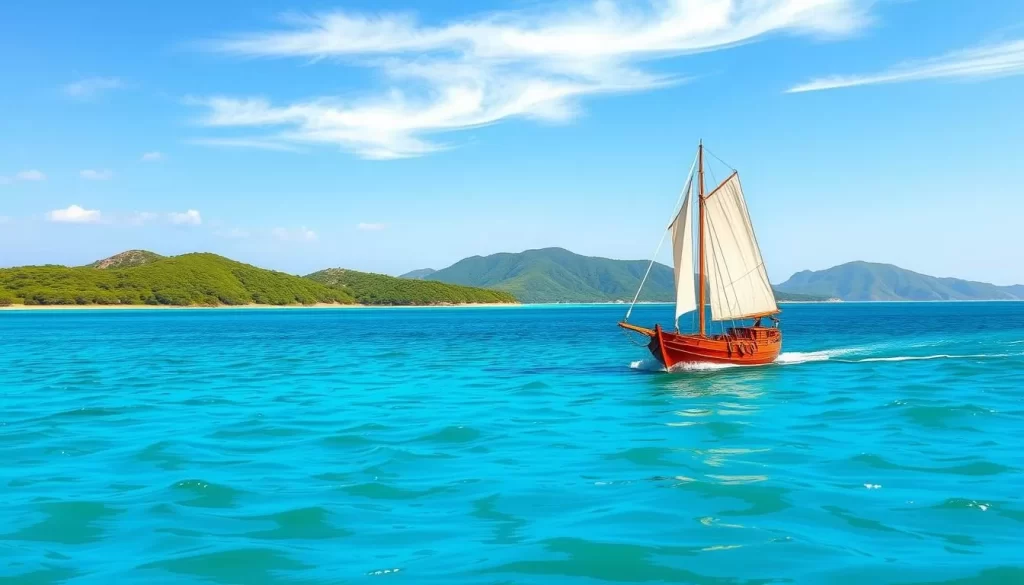
Embark on a sailing adventure like no other with the Safari Blue tour in Zanzibar, exploring the breathtaking Menai Bay Conservation Area. This full-day experience is a perfect blend of relaxation, adventure, and culinary delight, making it a must-do activity when visiting Zanzibar.
The Safari Blue Experience Tour begins with a morning pickup from your hotel in Zanzibar, followed by a scenic drive to the Fumba Peninsula. From there, you’ll board a traditional dhow boat, a vessel design that has been used by local fishermen and traders for centuries along the East African coast.
Traditional Dhow Sailing Experience
Sailing on a traditional wooden dhow boat is an experience in itself. As you glide across the crystal-clear waters of the Indian Ocean, you’ll have the chance to admire the breathtaking coastline and spot dolphins playing in the waves, if you’re lucky.
Snorkeling in Crystal Clear Waters
Upon arriving at Menai Bay, you’ll be provided with snorkeling equipment and given a briefing on the marine life you might encounter. The bay is home to a diverse array of coral reefs and colorful fish, making it a paradise for snorkelers.
Authentic Swahili Seafood Barbecue
After snorkeling and enjoying the white sandbank, you’ll be served a delicious Swahili seafood barbecue lunch on the secluded Kwale Island. The feast features freshly caught lobster, calamari, fish, and prawns, typically served with tropical fruits and local side dishes.
The Safari Blue tour is one of Zanzibar’s most popular day trips, offering an unforgettable sailing adventure through the protected waters of the Menai Bay Conservation Area. With its unique blend of sailing, snorkeling, and seafood, it’s an experience that will leave you with lifelong memories.
Jozani Forest: Encountering the Rare Red Colobus Monkeys
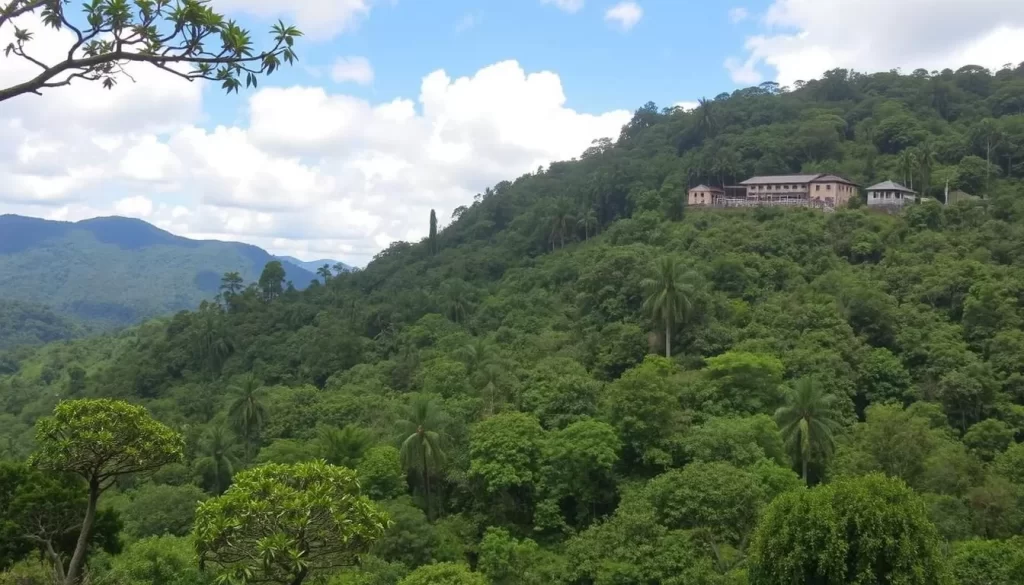
Nestled in the middle of the island, Jozani Chwaka Bay National Park is a treasure trove of biodiversity, featuring the critically endangered red colobus. As you visit Zanzibar, a trip to this conservation area offers a refreshing contrast to the coastal experiences, taking you into the island’s lush interior to encounter one of its most precious natural treasures.
Wildlife Conservation and Biodiversity
Jozani Chwaka Bay National Park is Zanzibar’s largest conservation area and only national park. It’s home to the endangered red colobus monkey, as well as other wildlife such as Sykes’ monkeys, bush babies, and a variety of bird species. The Zanzibar red colobus (Procolobus kirkii) is listed as an endangered primate species on the IUCN Red List, found exclusively on the islands of Unguja and Pemba in the Zanzibar Archipelago, off the coast of Tanzania.
The main threats to these monkeys include habitat loss due to deforestation, hunting for bushmeat, and the illegal pet trade. These arboreal monkeys are known for their striking reddish-brown fur, which sets them apart from other colobus species. Your guided tour through this conservation area will provide fascinating insights into the biodiversity of the forest ecosystem and the ongoing conservation efforts to protect these rare primates and their habitat around Zanzibar.
Mangrove Boardwalk and Ecosystem Exploration
Beyond the monkeys, Jozani Chwaka Bay is also home to a huge mangrove area; a unique coastal ecosystem with special trees and marine life. You can go on guided walks along wooden paths to see this environment up close without disturbing it. The experience continues with a walk along the elevated boardwalk through the mangrove forest, where you’ll learn about this critical coastal ecosystem that serves as a natural buffer against erosion and provides a nursery for many marine species.
As you explore the mangrove boardwalk, you’ll discover the intricate relationships between the mangroves, the creatures that inhabit them, and the role they play in the larger ecosystem. This exploration not only enhances your understanding of the conservation area but also highlights the importance of preserving such unique environments when you visit Zanzibar.
Cultural Immersion: Village Tours and Local Experiences
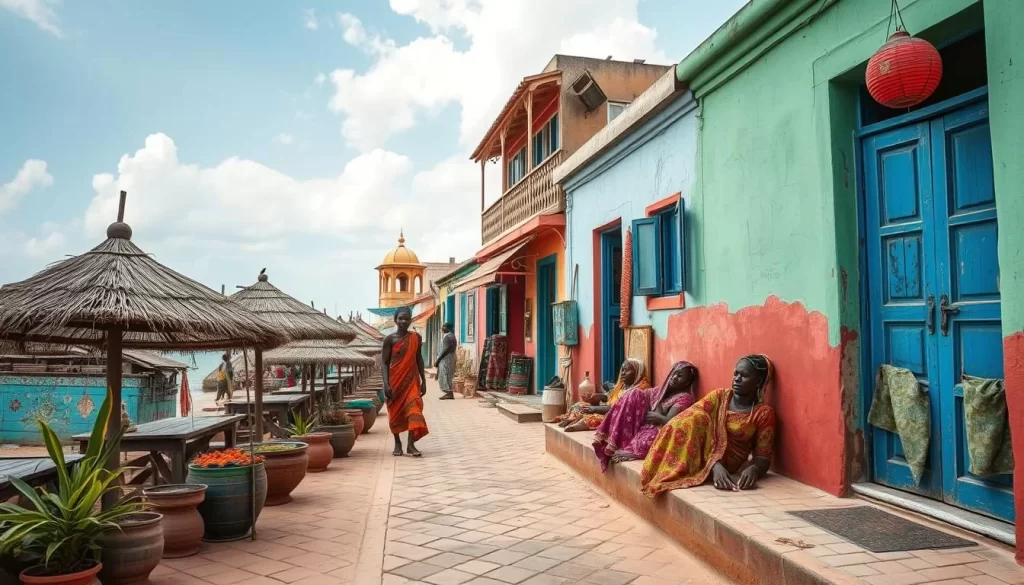
Experience the authentic Swahili way of life by visiting some of Zanzibar’s most fascinating villages. Village tours offer a unique glimpse into the island’s rich cultural heritage, allowing you to engage with local communities and learn about their traditions.
Jambiani Village: Women’s Seaweed Farming
Jambiani is one of Zanzibar’s most famous local villages, known for its female-led seaweed farming initiatives. During a tour, you can spend the day with these local women, learning about their sustainable seaweed farming practices and even trying your hand at weaving. It’s a place where tradition, empowerment, and creativity thrive, offering a truly immersive cultural experience.
The women of Jambiani wade into the shallow waters during low tide to tend their underwater gardens, a practice that has become a vital source of income for many local families. This experience not only provides insight into the daily lives of these women but also highlights the importance of sustainable practices in Zanzibar.
Nungwi Village: Traditional Dhow Building
One of the best things to do in Zanzibar is to spend an afternoon at Nungwi Village, located on Unguja Island. This village is the epicentre of Zanzibari dhow building, where craftsmen have worked on these beaches for centuries, creating beautiful vessels by hand. It’s also a thriving fishing village, offering a glimpse into the local way of life.
Nungwi is not only rich in culture and history but also known for its lively atmosphere, with beach resorts, hotels, bars, and restaurants that offer fun night-time entertainment. Visiting Nungwi Village near the famous Nungwi beach allows you to witness the ancient art of dhow building, where skilled craftsmen use traditional methods passed down through generations.
Authentic Interactions with Local Communities
These cultural tours create meaningful connections with local communities, allowing you to participate in daily activities, learn about traditional crafts, and gain insights into the authentic Swahili way of life. The lively atmosphere of these villages, with children playing, fishermen returning with their daily catch, and community members going about their routines, offers a refreshing contrast to the resort experience.
By visiting Zanzibar’s villages, you’re not just observing; you’re actively participating in the local culture. This immersive experience is one of the most authentic things to do in Zanzibar, providing a deeper understanding of the island’s soul and making your visit to Zanzibar truly unforgettable.
Nakupenda Sandbank: Paradise on a Pristine Sand Strip
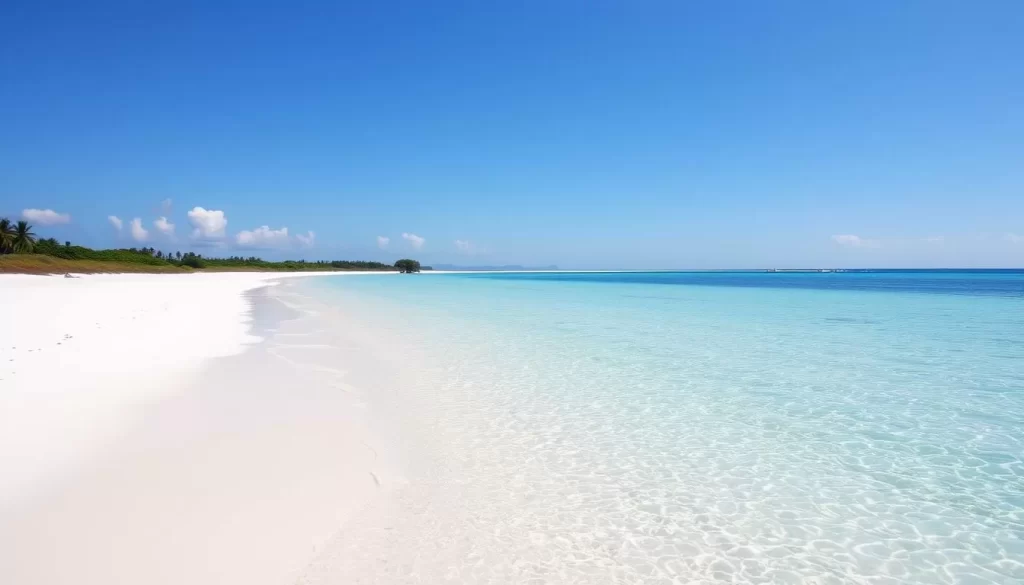
Imagine walking on a strip of white sand surrounded by turquoise waters; this is the magic of Nakupenda Sandbank. Located in the Indian Ocean, this sandbank is a natural wonder that appears during low tide, offering a surreal beach experience like no other.
Nakupenda Sandbank, which translates to “I love you” in Swahili, is a romantic paradise that emerges from the waters, providing a serene escape from the hustle and bustle of Stone Town. The sandbank is known for its white sand, considered some of the whitest in Africa, making it a perfect spot for swimming, sunbathing, and snorkeling in the crystal-clear waters.
Swimming and Sunbathing on the White Sand
The experience of being on Nakupenda Sandbank is nothing short of magical. As you step onto the sandbank, you’ll be greeted by the warm sun and the gentle lapping of the waves against the shore. The white sand is soft underfoot, inviting you to relax and soak in the tranquility of the surroundings.
Swimming in the crystal-clear waters offers an opportunity to spot a variety of marine life, including colorful fish and other creatures. The shallow waters provide excellent visibility, making it an ideal spot for snorkeling and exploring the underwater world.
Timing Your Visit with the Tides
One of the crucial aspects of visiting Nakupenda Sandbank is timing your trip according to the low tide. The sandbank is completely submerged during high tide, so it’s essential to plan your visit during the low tide to fully experience its beauty.
Most tours to Nakupenda Sandbank include a delicious seafood barbecue lunch prepared fresh on the sandbank. You can enjoy local delicacies such as grilled octopus, calamari, and fish, accompanied by fries and local fruits, all while taking in the breathtaking 360-degree ocean views.
To make the most of your visit, consider booking a tour with a reliable operator who can guide you on the best times to visit and ensure a smooth and enjoyable experience.
Culinary Delights: Zanzibar’s Food Scene
In Zanzibar, food is not just a meal, it’s an experience that blends African, Arab, Indian, and European flavors. The archipelago’s culinary scene is a reflection of its rich history and cultural diversity, shaped by centuries of trade and cultural exchange. As you explore Zanzibar, you’ll discover a unique fusion cuisine that is both delicious and aromatic.
Forodhani Gardens Night Market: Street Food Paradise

The Forodhani Gardens night market in Stone Town transforms each evening into a bustling street food paradise. You can sample local specialties like Zanzibar pizza, a savory crepe-like dish, fresh seafood skewers, sugar cane juice, and spiced coffee. The night market is a must-visit for any food enthusiast, offering a taste of the local culture and cuisine.
The Rock Restaurant: Dining on an Oceanic Outcrop

The Rock Restaurant is a Zanzibar icon, perched on a rock in the Indian Ocean. While it may be slightly overpriced and touristy, the experience is well worth it. You can walk to the island during low tide and enjoy fresh seafood, including grilled lobster, calamari, and prawns, paired with sweeping views of the water.
Spice-Infused Swahili Cuisine and Cooking Classes

Throughout Stone Town, you’ll find numerous restaurants serving authentic Swahili cuisine, characterized by its aromatic spice blends, coconut-based curries, and fresh seafood. Participating in a cooking class is a great way to learn about the local cuisine and bring the flavors of Zanzibar home with you. Local chefs will teach you how to prepare traditional dishes using the island’s famous spices and fresh ingredients.
Off the Beaten Path: Hidden Gems of the Archipelago
For those willing to venture off the beaten path, the Zanzibar Archipelago reveals its hidden gems. While many flock to the popular destinations, there are numerous fascinating things to do around Zanzibar that remain unseen by the average tourist.
Uzi Island: Untouched Rural Beauty

Uzi Island, located off the south coast of Unguja, is a hidden gem that offers a glimpse into untouched rural Zanzibari life. The island is accessible via a natural causeway that appears during low tide, creating a unique adventure even before you start exploring its pristine beaches and traditional fishing villages.
The island boasts a lush landscape featuring mangroves, banana and mango plantations, and towering baobab trees. As part of a conservation area, Uzi Island is rich in biodiversity, including seaweed, corals, and various plant species.
Kuza Cave: Freshwater Swimming in Ancient Limestone
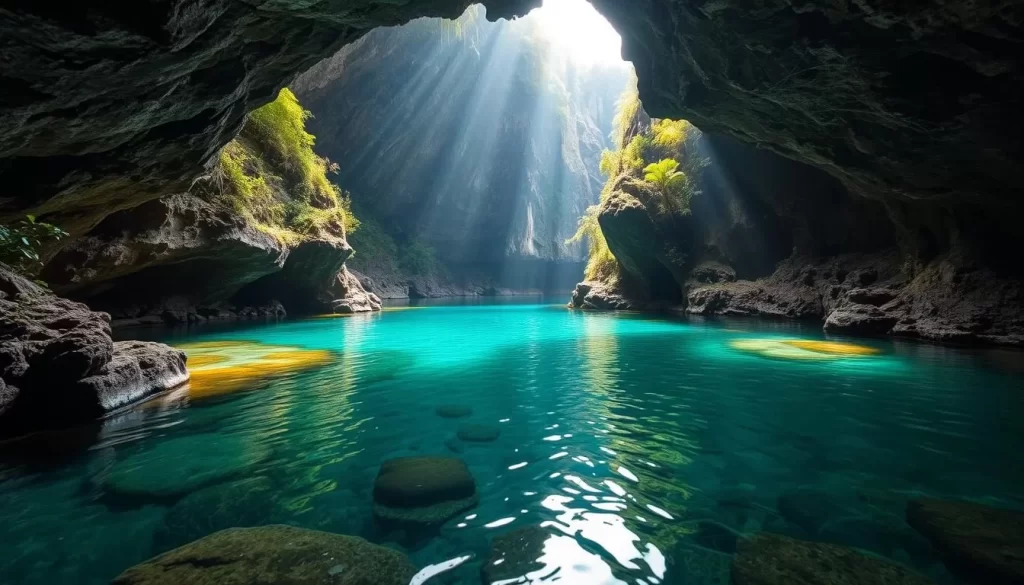
One of Zanzibar’s most magical natural wonders is Kuza Cave, a freshwater swimming hole inside an ancient limestone cave near Jambiani. The crystal-clear cool water provides a refreshing escape from the tropical heat, making it one Zanzibar experience you won’t forget.
While not suitable for those with claustrophobia, Kuza Cave is a breathtaking sight, with clear blue water surrounded by ancient limestone rock formations. Most tours offer the chance to swim into the cave and explore interesting artifacts found within.
Shiraz Ruins: Archaeological Wonders of Tumbatu
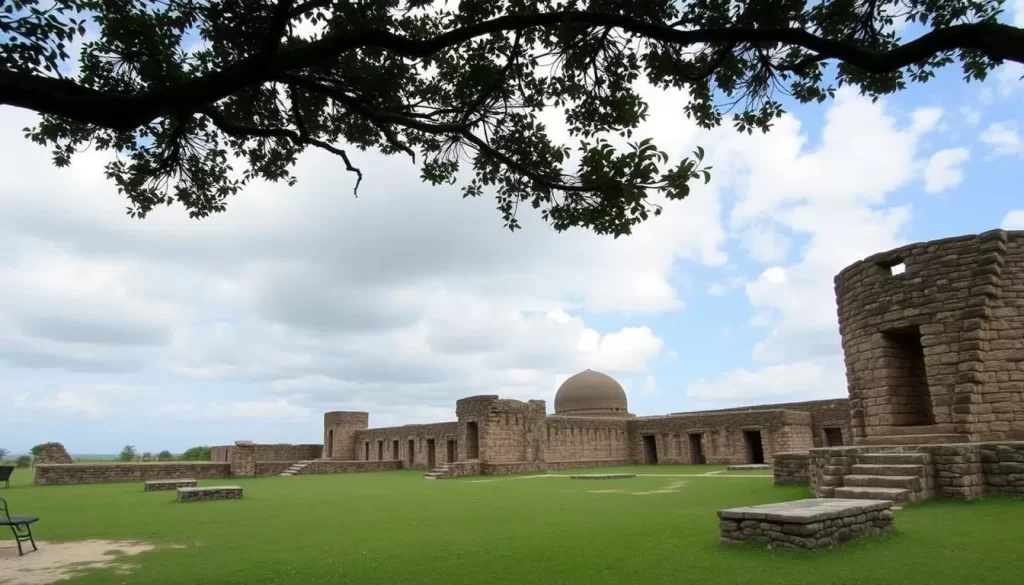
History buffs will be fascinated by the Shiraz Ruins on Tumbatu Island, archaeological remains that date back to the 12th century. These ruins tell the story of the Persian settlers who were among the earliest inhabitants of the archipelago, offering a glimpse into the rich history of the region.
Tumbatu Island, about a thirty-minute dhow trip from Nungwi or Unguja, is home to the Shirazi ruins at Makutani, which are supposedly the remains of one of the first-ever communities on the island.
Venturing beyond the popular tourist spots reveals some of the most fascinating things Zanzibar has to offer, where hidden gems await those willing to explore. These lesser-known attractions provide authentic experiences away from the crowds, allowing you to connect more deeply with the diverse landscapes, history, and communities that make up the rich tapestry of the Zanzibar Archipelago.
Sunset Experiences: Magical Evenings in Zanzibar
As the sun dips into the Indian Ocean, Zanzibar’s beaches and landmarks are set ablaze with a warm, golden light, creating unforgettable evening experiences. The archipelago’s unique position off the coast of Tanzania makes it an ideal location for witnessing spectacular sunsets. Whether you’re looking for a lively beach celebration or a sophisticated rooftop experience, Zanzibar has something for everyone.
Kendwa Beach Sunset Celebrations
Kendwa Beach on the northwest coast of Zanzibar is famous for its unobstructed sunset views over the Indian Ocean. As the day comes to a close, the beach transforms into a vibrant party scene with cushions set up on the sand and bonfires lit for evening celebrations, creating a lively atmosphere that’s hard to resist.
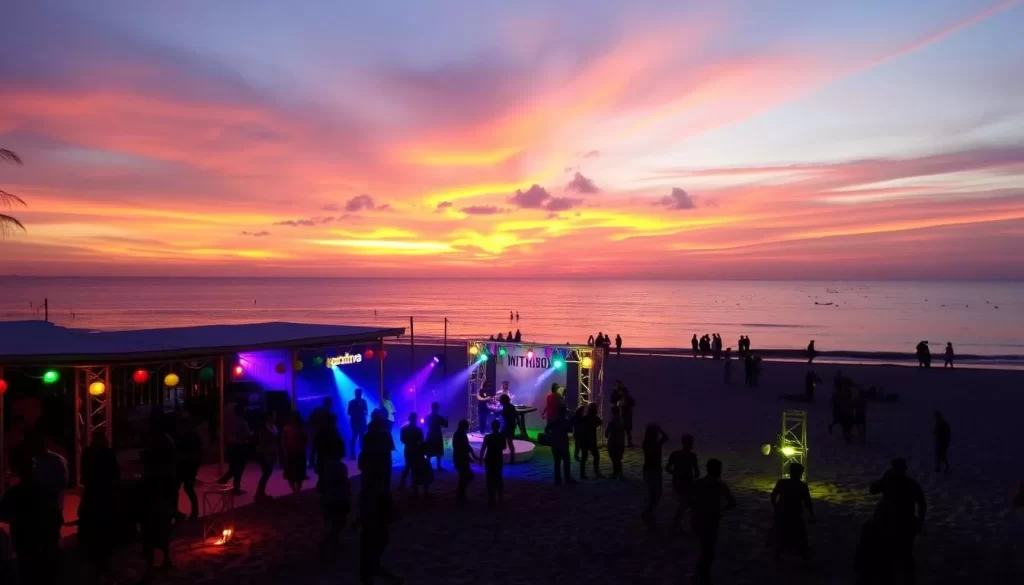
Sundowners at Africa House Hotel
For a more refined sunset experience, head to the historic Africa House Hotel in Stone Town. Originally built as a home for a Sultan in the 19th century, this iconic landmark offers sundowners on its rooftop terrace, where you can watch the sun set behind the Indian Ocean while sipping on a refreshing cocktail. Afterward, take a stroll to the nearby Forodhani Gardens, which come alive with food stalls and local entertainment, making for a perfect evening activity.
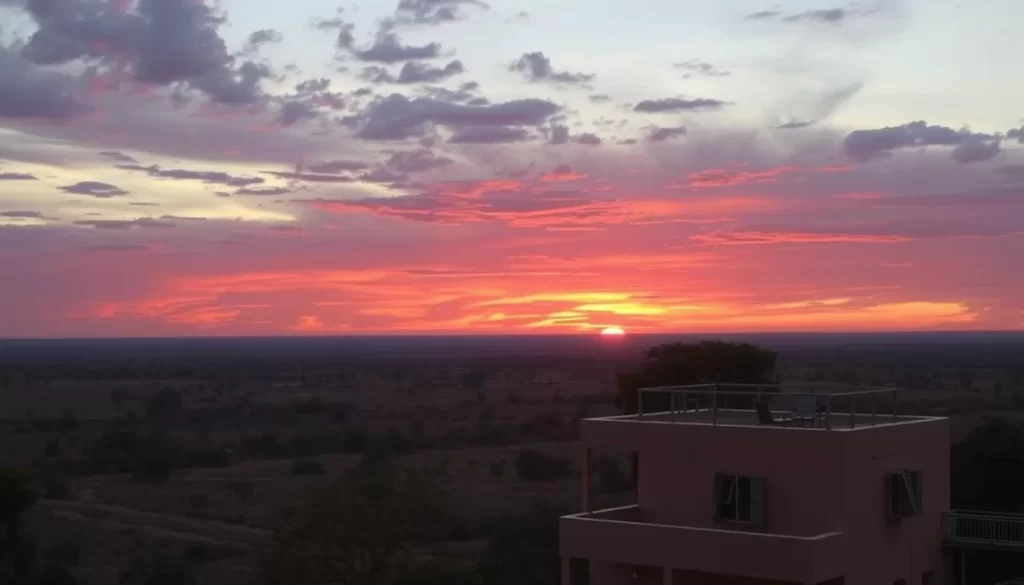
Zanzibar’s sunset experiences are a perfect blend of natural beauty and cultural richness, offering a unique way to cap off your day of island adventures. Whether you prefer the relaxed, beachy vibe of Kendwa or the historic elegance of Stone Town, you’re sure to find a sunset experience that suits your taste.
Practical Travel Tips for Exploring Zanzibar
Before you embark on your Zanzibar adventure, knowing the ins and outs of traveling around the island is vital. As you plan your trip, several practical considerations will ensure a smooth and enjoyable journey.
Getting Around: Transportation Options
Understanding your transportation options is essential when planning your visit to Zanzibar. Most visitors arrive via ferry from Dar es Salaam or flights to Zanzibar International Airport near Stone Town. Once on the island, you can get around using dala-dalas (local minibuses) for budget-friendly travel, taxis for convenience, or rental cars/scooters if you’re staying longer and want to explore at your own pace.
For those who prefer a more leisurely experience, many resorts offer shuttle services or can arrange for private transfers. If you’re staying in Stone Town, you can easily navigate the historic center on foot, taking in the local culture and architecture.
Accommodation Choices: From Budget to Luxury
Zanzibar offers a wide range of accommodations to suit every budget and preference. From backpacker hostels in Stone Town to mid-range beach bungalows and ultra-luxury resorts like Neptune Pwani Beach Resort and Essque Zalu, you can find the perfect place to stay. For a more intimate experience, consider boutique lodges like Hekaya Beach Hotel, which offers a swimming pool and a serene atmosphere.
When booking your accommodation, consider the location and the type of experience you’re looking for. Whether you’re looking to relax on the beach, explore local villages, or immerse yourself in the history of Stone Town, there’s an accommodation option to match your needs.
Respecting Local Customs and Etiquette
One of the most important things to remember when visiting Zanzibar is respecting local customs. The population is predominantly Muslim, so modest dress is appreciated, particularly when you’re away from tourist beaches and exploring local villages or Stone Town. Other practical considerations include carrying cash, as ATMs are limited outside Stone Town, negotiating prices for souvenirs and taxis, and staying hydrated in the tropical climate.
Being aware of the local pace of life is also crucial. Zanzibar has a relaxed atmosphere, so patience is essential when things don’t move as quickly as you might be accustomed to. By embracing the local culture and customs, you can have a more authentic and enjoyable experience during your visit to Zanzibar.
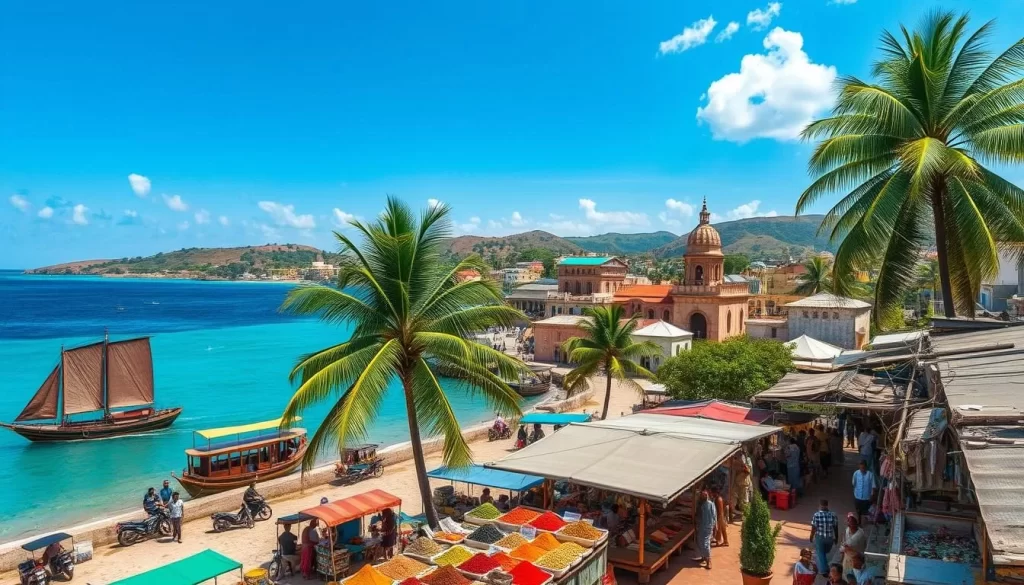
As you plan your trip to Zanzibar, incorporating these practical travel tips will help ensure a memorable and stress-free experience. Whether you’re looking to relax on the beautiful beaches, explore the historic Stone Town, or enjoy the local cuisine, Zanzibar has something to offer for every kind of traveler.
When to Visit: Seasons and Festivals in Zanzibar
To make the most of your Zanzibar experience, it’s crucial to know when to visit, considering the archipelago’s unique climate and festive calendar. Understanding the seasonal patterns will help you plan your activities and make the most of your trip.
Dry Season vs. Rainy Season: Weather Considerations
Zanzibar experiences two distinct dry seasons, which are generally considered the best times to visit. The long dry season spans from June to October, and a shorter dry season occurs from January to February. During these periods, you can enjoy sunny days with temperatures averaging 28-30°C (82-86°F), ideal for beach activities, scuba diving, and exploring the islands without the hindrance of heavy rainfall.
The dry seasons offer perfect conditions for outdoor activities. Here are some key points to consider:
- The long dry season from June to October is ideal for those who prefer warmer weather without the rain.
- The shorter dry season in January and February offers a great opportunity to enjoy the islands before the long rains begin.
- During the dry seasons, the sea is calm, making it perfect for scuba diving and snorkeling.
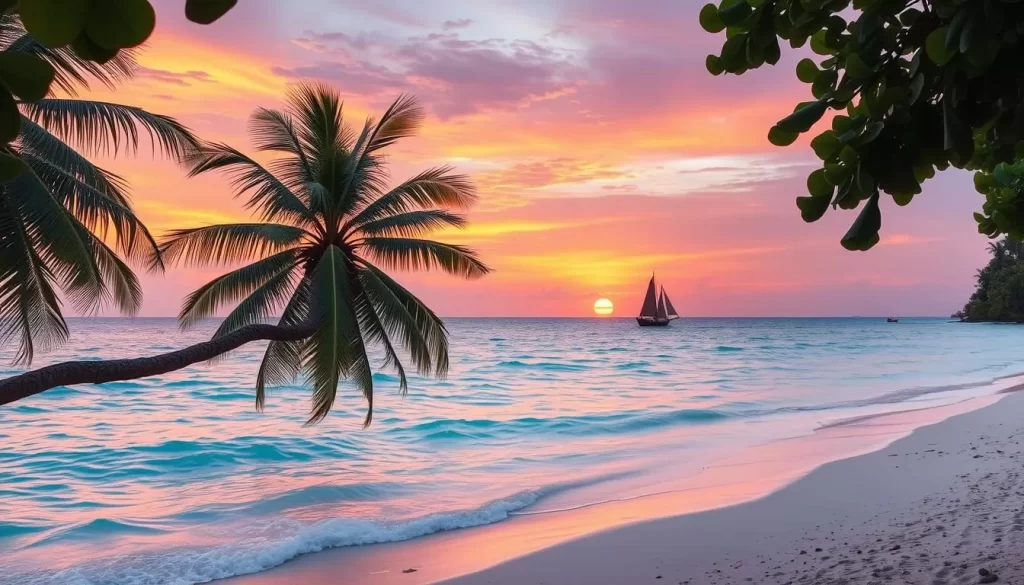
Cultural Festivals and Events Calendar
Beyond the weather considerations, timing your visit around Zanzibar’s cultural festivals can add a rich dimension to your trip. The archipelago hosts several vibrant cultural events throughout the year. Some of the notable festivals include:
- The Zanzibar International Film Festival in July, which showcases a diverse range of films from Africa and beyond.
- The Sauti za Busara music festival in February, celebrating African music and culture.
- The Dhow Countries Music Festival, which offers a unique musical experience.
These festivals not only provide entertainment but also offer a glimpse into the local culture and traditions. Planning your visit around these events can enhance your experience and create lasting memories.
The best time to visit Zanzibar ultimately depends on your priorities. Wildlife enthusiasts might prefer the dry season for clearer underwater visibility, budget travelers might opt for the shoulder seasons, while those interested in cultural immersion might plan around specific festivals.
Conclusion: Creating Unforgettable Memories in the Zanzibar Archipelago
The Zanzibar Archipelago offers an unforgettable journey through its historic landmarks, pristine beaches, and lush forests. As you’ve explored throughout this guide, the islands provide an extraordinary blend of experiences that make it one of the best tropical destinations in East Africa.
From the historic streets of Stone Town to the pristine beaches, vibrant coral reefs, and spice plantations, the things to do in Zanzibar cater to every type of traveler seeking authentic cultural immersion and natural beauty. Whether you’re planning to visit Zanzibar for a few days or a few weeks, including both iconic attractions and hidden gems in your itinerary will ensure you experience the full spectrum of what makes this archipelago so special.
The best time to visit and the best things to do will depend on your personal interests. However, one thing is certain – the warm hospitality of the Zanzibari people will make you feel welcome throughout your journey. As you plan your trip, consider the time to visit that suits you best, and get ready to be enchanted by the unique charm of the Zanzibar Archipelago.
As you depart this magical island paradise, you’ll carry with you not just photographs and souvenirs, but unforgettable memories of one of Africa’s most enchanting destinations – memories that will likely have you planning your return before you’ve even reached home. With its rich history, stunning beaches, and vibrant culture, the Zanzibar Archipelago is truly a destination that will leave you with one of the best travel experiences of your life.
The above is subject to change.
Check back often to TRAVEL.COM for the latest travel tips and deals.
